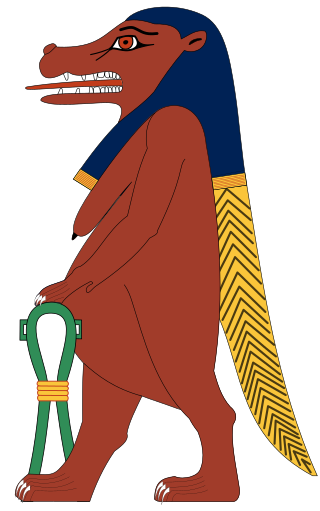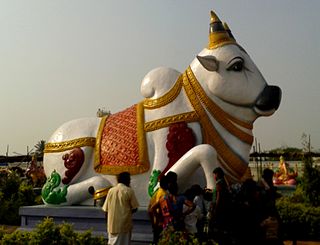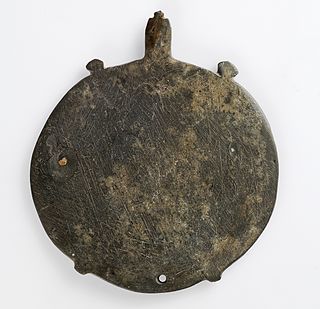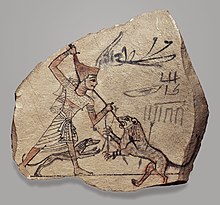
The hippopotamus, also shortened to hippo, further qualified as the common hippopotamus, Nile hippopotamus, or river hippopotamus, is a large semiaquatic mammal native to sub-Saharan Africa. It is one of only two extant species in the family Hippopotamidae, the other being the pygmy hippopotamus. Its name comes from the ancient Greek for "river horse" (ἱπποπόταμος).

Hunting is the human practice of seeking, pursuing, capturing, or killing wildlife or feral animals. The most common reasons for humans to hunt are to exploit the animal's body for meat and useful animal products, for recreation/taxidermy, although it may also be done for non-exploitative reasons such as removing predators dangerous to humans or domestic animals, to eliminate pests and nuisance animals that damage crops/livestock/poultry or spread diseases, for trade/tourism, or for ecological conservation against overpopulation and invasive species.

Spearfishing is fishing using handheld elongated, sharp-pointed tools such as a spear, gig, or harpoon, to impaling the fish in the body. It was one of the earliest fishing techniques used by mankind, and has been deployed in artisanal fishing throughout the world for millennia. Early civilizations were familiar with the custom of spearing fish from rivers and streams using sharpened sticks.

A speargun is a ranged underwater fishing device designed to launch a tethered spear or harpoon to impale fish or other marine animals and targets. Spearguns are used in sport fishing and underwater target shooting. The two basic types are pneumatic and elastic. Spear types come in a number of varieties including threaded, break-away and lined. Floats and buoys are common accessories when targeting larger fish.

Bait is any appetizing substance used to attract prey when hunting or fishing, most commonly in the form of trapping, ambushing and angling.

In Ancient Egyptian religion, Taweret is the protective ancient Egyptian goddess of childbirth and fertility. The name "Taweret" means "she who is great" or simply "great one", a common pacificatory address to dangerous deities. The deity is typically depicted as a bipedal female hippopotamus with feline attributes, pendulous female human breasts, the limbs and paws of a lion, and the back and tail of a Nile crocodile. She commonly bears the epithets "Lady of Heaven", "Mistress of the Horizon", "She Who Removes Water", "Mistress of Pure Water", and "Lady of the Birth House".

Animal worship is an umbrella term designating religious or ritual practices involving animals. This includes the worship of animal deities or animal sacrifice. An animal 'cult' is formed when a species is taken to represent a religious figure. Animal cults can be classified according to their formal features or by their symbolic content.

Animals in sport are a specific form of working animals. Many animals, at least in more commercial sports, are highly trained. Two of the most common animals in sport are horses and dogs.

Ultime grida dalla savana, also known as by its English title Savage Man Savage Beast, is a 1975 Italian mondo documentary film co-produced, co-written, co-edited and co-directed by Antonio Climati and Mario Morra. Filmed all around the world, its central theme focuses on hunting and the interaction between man and animal. Like many mondo films, the filmmakers claim to document real, bizarre and violent behavior and customs, although some scenes were actually staged. It is narrated by the Italian actor and popular dubber Giuseppe Rinaldi and the text was written by Italian novelist Alberto Moravia.

The zoomorphic palette is a type of cosmetic palette made during the predynastic period of Egypt. The palettes are found at burial sites, for example Abydos in the second half of the 4th millennium BC.

The wildlife of Egypt is composed of the flora and fauna of this country in northeastern Africa and southwestern Asia, and is substantial and varied. Apart from the fertile Nile Valley, which bisects the country from south to north, the majority of Egypt's landscape is desert, with a few scattered oases. It has long coastlines on the Mediterranean Sea, the Gulf of Suez, the Gulf of Aqaba and the Red Sea. Each geographic region has a diversity of plants and animals each adapted to its own particular habitat.

Fishing techniques are methods for catching fish. The term may also be applied to methods for catching other aquatic animals such as molluscs and edible marine invertebrates.
The following outline is provided as an overview of and topical guide to fishing:
The Kanawha Valley prehistoric people were an ancestor group for today's modern American Indian. The Kanawha Valley's paleo-Amerindians came to North America from Siberia over 12,500 years ago.

The Hunters Palette or Lion Hunt Palette is a c. 3100 BCE cosmetic palette from the Naqada III period of late prehistoric Egypt. The palette is broken: part is held by the British Museum and part is in the collection of the Louvre.

Field sports are outdoor sports that take place in the wilderness or sparsely populated rural areas, where there are vast areas of uninhabited greenfields. The term specifically refers to activities that mandate sufficiently large open spaces and/or interaction with natural ecosystems, including hiking/canyoning, equestrianism, hawking, archery and shooting, but can also extend to various surface water sports such as river trekking, angling, rowing/paddling, rafting and boating/yachting.

Human uses of animals include both practical uses, such as the production of food and clothing, and symbolic uses, such as in art, literature, mythology, and religion. All of these are elements of culture, broadly understood. Animals used in these ways include fish, crustaceans, insects, molluscs, mammals and birds.
Animals had a variety of roles and functions in ancient Greece and Rome. Fish and birds were served as food. Species such as donkeys and horses served as work animals. The military used elephants. It was common to keep animals such as parrots, cats, or dogs as pets. Many animals held important places in the Graeco-Roman religion or culture. For example, owls symbolized wisdom and were associated with Athena. Humans would form close relationships with their animals in antiquity. Philosophers often debated about the nature of animals and humans. Many believed that the fundamental difference was that humans were capable of reason while animals were not. Philosophers such as Porphyry advocated for veganism.

















